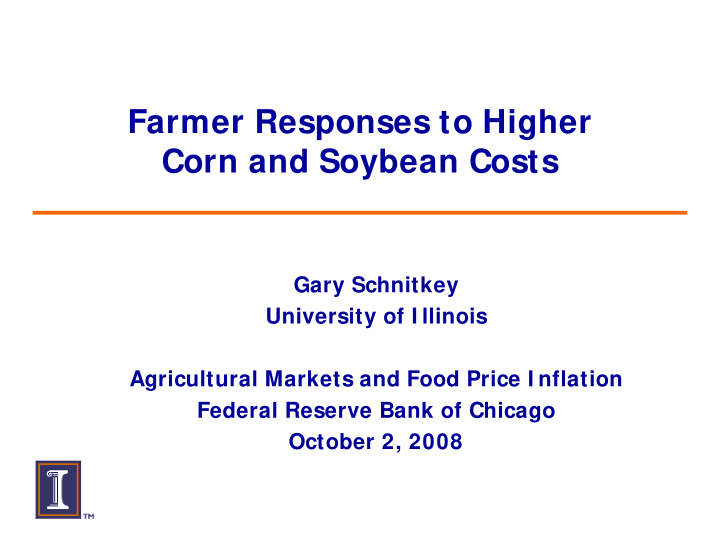



Farmer Responses to Higher Corn and Soybean Costs Gary Schnitkey University of I llinois Agricultural Markets and Food Price I nflation Federal Reserve Bank of Chicago October 2, 2008
Outline • Corn and soybean cost increases Key division: non-land costs versus land costs (cash rents) • Responses to crop cost increases • Livestock costs and responses
Corn and Soybean Non-Land Costs, Central I llinois, High Productivity Farmland, 1972 – 2009P
Per Acre Change in Costs, 2008 to 2009P I tem Corn Soybeans Fertilizer $97 $53 Seed 48 13 Power * 12 9 Crop insurance 7 4 I nterest 4 3 Other 13 4 Total $181 $85 * Includes machinery repairs, depreciation, hire, and fuel.
Non-Land Costs and Crude Oil Prices
Factors I mpacting Crop Costs Correlation Coefficients, 1972 - 2006 Per Acre Costs Crude Oil CPI Corn .82 .84 Soybeans .75 .85 Factors impacting costs include energy prices, world demands for foods, weak U.S. dollar Significant probability that costs could come down, introduces risks when purchasing inputs Not sure that would increase crop farm returns as decline in the above factors also likely to put downward pressure on grain prices
Revenue, Non-Land Costs and Returns, Corn, Central I llinois, High Productivity Farmland Operator & land return = gross revenue – non-land costs, represents return remaining to pay for land and provide the farmer a return
Returns and Rents, Corn, Central I llinois, High Productivity Farmland Year Operator & Cash Farmer Land Return Rent Return Farmer return 2000 $173 $132 $41 averaged about $55 2001 169 137 32 per acre from 2000 2002 143 137 6 to 2005. 2003 232 140 92 2004 248 143 105 Central question: 2005 206 147 59 What will be the 2006 285 150 135 new “farmer” return 2007 488 166 322 bid into the market? 2008P 636 188 448 2009P 448 210 238
Besides Costs and Prices, Risks Have Also I ncreased Risk I ncreases Reasons for I ncreases More volatile commodity Between 1995 and 2005, • • prices and costs farmer return averaged $55 per acre ($40 if 1995 to 2000 is included) Less protection from Federal • commodity price programs For the same risk level, farmer • return has to average $120 Larger losses before crop • per acre post 2006 insurance makes payments
Farmer Responses 1. Rental decisions 2. Crop decisions: Corn versus soybeans 3. Earlier purchases of inputs, particularly fertilizer 4. More borrowing 5. Other implications (new risks)
Rental Decisions I mportance of rental decisions to “commercial” grain farms • – 50% of farmland in U.S. is rented – About 70% in I llinois is rented – 84% of farmland by I llinois FBFM pure grain farms is rented Percent Rented by Farm Size, I llinois FBFM Grain Farms Acre Range % rented 100 – 499 53% 500 – 799 73% 800 – 1,199 80% 1,200 – 1,999 81% 2,000 – 2,999 89% Over 3,000 85%
Rental Decisions • Higher returns cause higher rents and higher land values (capitalization) • Reach a point where farmer return recognizes capital, risk, and management contributions of farmers • Question: Will the market recognize a need for a higher farmer return post 2006?
Rental Decisions • Some circumstantial evidence, farmer margins may be larger post 2006 • But, will see continued increases on high productivity farmland (I llinois Society of Professional Farm Managers and Rural Appraisers indicate rents will increase by $43 per acre in 2009) • Cost increases would suggest rent declines on lower productivity farmland. Post 2006 environment suggests much larger range in cash rents for different qualities of farmland
Rental Decisions • Other changes: – Shorter lease terms – many more leases of one year term – Some increase in variable cash rents. Farm Service Agency interpretation of cash leases (and attendant switches in commodity program payments) is a major hindrance to movement to variable cash lease. • I n future years, many will have to reduce rental payments when projected returns decline
Crop Decisions: Corn Versus Soybeans Corn returns still exceed soybeans by a large margin, but will farmers go to lower “cost” crops.
Other Responses • Earlier purchases: Many farmers have purchased fertilizer for 2009, had to pay for a portion or all of the input price • More borrowing: More than a doubling of operating requirements
Other I mplications Counterparty and “chain” risk has increased • – Risk of a party not performing (default) on their contracts is higher – Disruptions of supply or processing chain will be the cause of the next financial crisis. Much higher break-even prices • – Commodity prices will not decrease to old levels – Prices will still be higher even if ethanol credits are reduced
Break-even Corn Prices to Cover Costs (Central I llinois, High Productivity Farmland) 4.50 4.00 Break-even (with land) 3.50 Target price - direct rate 3.00 $ per bueshl 2.50 2.00 1.50 1.00 Break-even (without land) 0.50 0.00 00 01 02 03 04 05 06 07 08 09 Year
Quarterly Hog Production Costs, I llinois, 2004 to 2008(2)
Quarterly Hog Prices and Costs, I llinois, 2004 to 2008(2)
Livestock • What will the adjustment process look like moving to higher production costs? – Higher cost means an adjustment to higher prices but lower quantity – How do you get to lower quantity? Will it be with financial pain? • Who is currently bearing the losses depend on contractual arrangements
Summary Costs have increased dramatically, little chance that there • will be reductions in the next year or two, but chance of declines in the future Risks, as well as costs and prices, have increased • New environment due to scarcity of basic resources (energy • and fertilizers) What is going to be the public policy response to energy? • Adjustments • Cash rents (and farmland prices) on grain farms – Supply and prices on livestock farms –
Recommend
More recommend